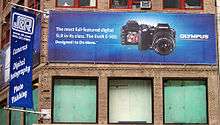Olympus E-500
 | |
| Overview | |
|---|---|
| Type | Digital single-lens reflex |
| Lens | |
| Lens | Interchangeable (Four Thirds mount) |
| Sensor/Medium | |
| Sensor | Kodak KAF-8300CE Four Thirds System FFT-CCD |
| Maximum resolution | 3,264 × 2,448 (8 million) |
| ASA/ISO range | ISO 50–3200 |
| Storage | CompactFlash (Type I or Type II); XD card |
| Focusing | |
| Focus modes | Single shot AF, Continuous AF and/or Manual |
| Focus areas | 3-Point Multiple AF |
| Exposure/Metering | |
| Exposure modes | Automatic, Portrait, Landscape, Landscape and Portrait, Macro, Sport, Night Portrait, Night Scene, Children, High Key, Low Key, Candle, Sunset, Fireworks, Documents, Beach and Snow, Manual, Aperture Priority, Shutter Priority |
| Exposure metering | TTL full-aperture exposure metering system |
| Metering modes | Spot, Center Weighted, Digital ESP |
| Flash | |
| Flash | Built-in TTL Speedlight with hotshoe |
| Flash bracketing | +5/−5 EV in 1/3, 1/2 or 1 step |
| Shutter | |
| Shutter | Computerized focal-plane type |
| Shutter speed range | 1/4000 to 60 s (max 8 Min in "Bulb" mode) |
| Continuous shooting | 2.5 frame/s, unlimited shots (JPEG) or 4 shots (RAW/TIFF) |
| Viewfinder | |
| Viewfinder | Optical TTL with pentamirror |
| Image Processing | |
| Custom WB | Automatic, Incandescent, Fluorescent, Direct Sunlight, Flash, Cloudy, Shade, Preset (in kelvins) |
| General | |
| Rear LCD monitor | 2.5 in (64 mm), 215 kpixel |
| Battery | Olympus BLM-1 family |
| Weight | 430 g (0.95 lb) without battery |
| Made in | China |
The Olympus E-500 (Olympus EVOLT E-500 in North America) is an 8-megapixel digital SLR camera manufactured by Olympus of Japan and based on the Four Thirds System. It was announced on 26 September 2005. Like the E-300 launched the previous year, it uses a Full Frame Transfer Kodak KAF-8300CE CCD imaging chip.
Features
Unlike the E-300 and the E-300's successor, the Olympus E-330, the E-500 retains the traditional SLR appearance, with a humped pentamirror box instead of the E-300's unique Porro mirror arrangement. The mirror box also bears the onboard flash, in similar manner to most recent consumer-level SLR cameras. The viewfinder hump means the E-500 is taller than the E-300, but in other dimensions it is smaller.
The E-500 uses Olympus' patented Supersonic Wave Filter dust reduction system to shake dust from the sensor during startup and when requested by the user; this largely eliminates the problem of dust accumulation on the surface of the image sensor. Image processing is done with Olympus' TruePic Turbo system.

Improvements over the E-300 include a 2.5-inch (64 mm) rear LCD screen, 49 zone metering (the E-300's total is undocumented, but believed to be 3), spot metering, an RGB histogram to identify clipping across the three color channels in post-shot review, optional improved noise filtering for low-light photography, and the ability to apply software color filters in black-and-white shooting.
In a buyers guide distributed by the UK Digital SLR magazine (December 06, 2nd edition), the Olympus E-500 camera was identified as an intermediate digital SLR camera — capable of functioning as a professional tool in most situations, well above what the average street price of £379 (at time of article) reflects.
The E-500 was available in five different packages in the United States; these were:
- Body only (no lens)
- Body plus 14–45 mm Zuiko Digital lens
- Body plus 17.5–45 mm Zuiko Digital lens
- Body plus 14–45 mm and 40–150 mm Zuiko Digital lenses
- Body plus 17.5–45 mm and 40–150 mm Zuiko Digital lenses (Costco in-store package)
The successor to the E-500 is the E-510. Released in 2007, the E-510 provides several feature improvements including a new 10-megapixel Live MOS Sensor with claimed lower image noise at high ISO compared to the E-500, LiveView and in-body Image Stabilization in approximately the same body size as the E-500.
External links
![]() Media related to Olympus E-500 at Wikimedia Commons
Media related to Olympus E-500 at Wikimedia Commons
- E-500 at Olympus America.
- Full review at DPreview.com.
- Olympus E-500 Sample Photos and Tests
| Olympus Four Thirds System Digital SLR timeline | ||||||||||||||||||||||||||||||||||||||||||||||||||||||||||||||||||||||||||||||||||||||||||||||||||||||||||||||||||||||||||||||||||||||||||||||||||||||||||||||||||||||||||||||||||||||||||||||||||||||||||||||||||||||||||||||||||||||||||||||||||||||||||||||||||||||||||||||||||||||||||||||||||||||||||||||||||||||||||||||||||||||||||||||||||||||||||||||||||||||||||||||||||||||||||||||||||||||||
|---|---|---|---|---|---|---|---|---|---|---|---|---|---|---|---|---|---|---|---|---|---|---|---|---|---|---|---|---|---|---|---|---|---|---|---|---|---|---|---|---|---|---|---|---|---|---|---|---|---|---|---|---|---|---|---|---|---|---|---|---|---|---|---|---|---|---|---|---|---|---|---|---|---|---|---|---|---|---|---|---|---|---|---|---|---|---|---|---|---|---|---|---|---|---|---|---|---|---|---|---|---|---|---|---|---|---|---|---|---|---|---|---|---|---|---|---|---|---|---|---|---|---|---|---|---|---|---|---|---|---|---|---|---|---|---|---|---|---|---|---|---|---|---|---|---|---|---|---|---|---|---|---|---|---|---|---|---|---|---|---|---|---|---|---|---|---|---|---|---|---|---|---|---|---|---|---|---|---|---|---|---|---|---|---|---|---|---|---|---|---|---|---|---|---|---|---|---|---|---|---|---|---|---|---|---|---|---|---|---|---|---|---|---|---|---|---|---|---|---|---|---|---|---|---|---|---|---|---|---|---|---|---|---|---|---|---|---|---|---|---|---|---|---|---|---|---|---|---|---|---|---|---|---|---|---|---|---|---|---|---|---|---|---|---|---|---|---|---|---|---|---|---|---|---|---|---|---|---|---|---|---|---|---|---|---|---|---|---|---|---|---|---|---|---|---|---|---|---|---|---|---|---|---|---|---|---|---|---|---|---|---|---|---|---|---|---|---|---|---|---|---|---|---|---|---|---|---|---|---|---|---|---|---|---|---|---|---|---|---|---|---|---|---|---|---|---|---|---|---|---|---|---|---|---|---|---|---|---|---|---|---|---|---|---|---|---|---|---|---|---|---|---|---|---|---|---|---|---|---|---|---|---|---|---|---|---|---|---|---|---|---|---|
Green background indicates cameras with in-body stabilization. | ||||||||||||||||||||||||||||||||||||||||||||||||||||||||||||||||||||||||||||||||||||||||||||||||||||||||||||||||||||||||||||||||||||||||||||||||||||||||||||||||||||||||||||||||||||||||||||||||||||||||||||||||||||||||||||||||||||||||||||||||||||||||||||||||||||||||||||||||||||||||||||||||||||||||||||||||||||||||||||||||||||||||||||||||||||||||||||||||||||||||||||||||||||||||||||||||||||||||